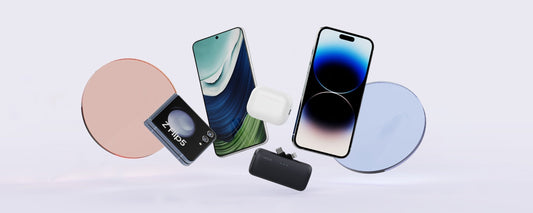Charging without cables feels like magic. All you need to do is place your phone on a pad, and boom—it starts charging! No more fumbling for cables, no more worn-out charging ports, just effortless power.
It's no wonder that wireless charging is everywhere. It’s built into smartphones, smartwatches, earbuds, and even electric toothbrushes.
But despite its popularity, there are still plenty of myths floating around. Some say it’s slower, others worry about overheating, and a few even wonder if it’s bad for their phone’s battery.
So, what’s the truth? How does wireless charging work? And is it the right choice for you? We’re breaking it all down in this guide, so you’ll know exactly what’s happening when your device powers up wirelessly.
What is wireless charging?
Wireless charging is a technology that allows you to charge electronic devices without plugging in a charging cable. Instead, it uses wireless power transfer to deliver energy from a charging station or pad to your device. This is possible thanks to a built-in charging system that works through electromagnetic fields.
This means your phone, smartwatch, or even laptop can charge just by resting on a compatible wireless charger—no cables needed. It’s a game-changer for convenience, reducing clutter and wear on charging ports.
The technology isn’t new, though. It has been around for years, powering everything from electric toothbrushes to high-end smartphones like the latest Samsung Galaxy and Apple iPhone models. Today, it’s more advanced than ever, with faster charging speeds and wider compatibility across devices.
How does wireless charging works?
Wireless charging might seem like magic, but it’s all about science! It relies on electromagnetic fields and the flow of electric current to transfer power between your charger and your device without any physical connection.
What most people don’t know is that there are actually many different types of wireless charging technologies. For consumer tech, most wireless chargers use inductive charging, a type of wireless power transfer that works over short distances.
For this type of wireless charging, the process begins when the wireless charger is plugged into an outlet. This allows electric current to flow into it. Inside, there's a coil of wire, and as that electric current moves through it, it creates an electromagnetic field around the pad. Because the current is alternating, this magnetic field is constantly changing, kind of like a pulsating energy source.
Inside your device, there's another coil, the receiver coil. When you place your phone (or another compatible device) on the charging pad, this coil interacts with the electromagnetic field.
Now, here's where the magic happens: electromagnetic induction. The charging pad's changing magnetic field reaches the receiver coil in your device, and this causes an electric current to flow within that coil. It's like the magnetic field is passing its energy to the receiver coil.
But there's a twist! The electric current induced in the receiver coil is alternating current (AC), but your device's battery needs direct current (DC) to charge. That's why devices that support wireless charging have a built-in converter (a rectifier) that transforms the AC current into a DC current. This DC current then flows into the battery, giving it the charge it needs.
So, to put it simply, wireless charging uses electric current to generate a magnetic field, which then induces an electric current in your device, enabling you to charge without those pesky cables.
Qi Standard or MagSafe: which one should you go for?
Now that you’ve got the basics of wireless charging, let’s dive into the two biggest names in the game: Qi and MagSafe. You’ve probably heard of them, but do you really know what sets them apart?
Qi, pronounced "chee," is the universal wireless charging standard developed by the Wireless Power Consortium (WPC). You'll find Qi wireless charging in almost all types of wireless charging tech, including smartphones (like many Android phones from Samsung), tablets, and accessories.
MagSafe, on the other hand, is Apple's own take on wireless charging. It’s built on the Qi standard but with a clever twist—magnets! These magnets help your iPhone snap perfectly into place on the charger, ensuring a strong connection and more efficient charging. First introduced with the iPhone 12, MagSafe can even deliver faster speeds than regular Qi charging.
Now, here’s where it gets even better. The Qi standard’s latest update, the Qi2, is here, and it’s a total game-changer. It combines the best of both worlds by integrating magnets, just like MagSafe, but it’s designed for even wider compatibility across different brands. Plus, thanks to dual copper coils, Qi2 controls temperature better, so your device stays cooler while charging faster. If you’ve got an iPhone 12 or newer or are planning an upgrade soon, Qi2 is a future-proof choice.
Which devices work with wireless chargers?
You might be surprised by just how many devices can charge wirelessly these days! While smartphones are the most common, wireless charging is becoming a go-to feature for many other gadgets. Here’s a look at what you can power up without plugging in:
Smartphones
Most modern phones support wireless charging, including many Android phones and iPhones that work with Qi chargers or MagSafe.
Laptops
Some newer laptops now feature wireless charging, letting you ditch the bulky cables. While it’s not yet as common as phone charging, brands like Dell and Lenovo are rolling out Qi-compatible models.
Smartwatches
Many smartwatches support wireless charging, including Apple’s own Apple Watch, which uses a magnetic charging puck instead of a standard Qi charger.
Electric toothbrushes
Believe it or not, electric toothbrushes were among the first devices to use wireless charging! Many models sit on a charging dock that uses induction to power them up.
Qi-compatible accessories
Wireless Qi chargers can also power up devices like earbuds, wireless keyboards, and even some portable battery packs.
The Perks of Charging Without Cables
Wireless charging is more than just a trend — it’s a smarter, cleaner, and more seamless way to power up your devices. Here’s why more and more people are making the switch:
1. Super easy to use - It's just so convenient. You simply pop your device on the charging pad, and that's it! No more messing with cables or trying to figure out which way the connector goes.
2. Clutter-free - You can say goodbye to all those tangled wires! Wireless charging helps keep things tidy by getting rid of the need for lots of different cables and adapters.
3. No wear and tear on charging ports - Since you're not constantly plugging and unplugging, wireless charging helps keep your device's charging port in good shape, which could mean it lasts longer.
4. No more cable breakage - We've all been there with broken charging cables, right? Well, wireless charging means you don't have to worry about that anymore.
5. Safer connections - It's also safer because there aren't any exposed electrical contacts, so there's less chance of electrical shocks or short circuits.
6. Universal compatibility - The Qi standard is used everywhere, so loads of devices and chargers work together. This makes charging simpler, as you can often use the same charger for different gadgets.
7. Magnetic alignment - With tech like MagSafe, the device snaps perfectly into place on the charging pad, making charging more efficient and reliable. It also makes everything work better!
Why wireless charging isn’t always the best option
While wireless charging is great, there are some downsides you should know about:
Slower than wired charging: Wireless charging is usually slower than plugging in. Even with improvements in fast charging, plugging into a cable is still the quickest way to charge your device.
It gets warm fast: Wireless chargers can get hot pretty quickly, which could lead to overheating, especially in settings with limited airflow. If it gets too hot, it could cause problems for your device or the charger in the long run.
Less energy efficient: Wireless charging uses more energy than charging with a cable. So, you end up using more power from the power source to get the same amount of charge.
Limited range: You've got to keep your device pretty close to the charging pad and their wireless coils aligned for it to work. If you move it too far away, it’ll stop working. And if the coils aren’t properly aligned, it can lead to overheating and damaging both products.
Not always case-compatible: You might have to take your phone case off to charge wirelessly, especially if it's a thick case or made of certain materials.
More expensive: Wireless chargers usually cost more than regular chargers that you plug in.
Is wireless charging safe? Let’s clear it up!
Yes! Wireless charging is usually safe as long as you're using good-quality chargers from brands you trust. Since there aren't any exposed metal bits, you're less likely to get shocked or have a short circuit compared to plugging in. Most wireless chargers also have safety features built in to stop them from overheating, overcharging, or having power surges.
But, like with any tech, there are a few things to keep in mind. Here's how to keep things safe:
1. Use certified chargers: Get your wireless chargers from well-known, trusted brands, and make sure they're certified, like Cygnett wireless chargers. Don't cheap out on those uncertified chargers, as they might not have the safety features you need.
2. Avoid extreme temperatures: Don't put your wireless charger or your phone in direct sunlight or near anything that gets really hot. That can cause overheating.
3. Remove metallic objects: Make sure there's nothing metal (like keys or coins) between your phone and the charging pad. Metal can mess with the charging and make things heat up.
4. Use compatible devices and chargers: Always use devices and chargers that work with the same wireless charging standard.
5. Don't overcharge: Most new devices prevent overcharging, but it's still a good idea not to leave your phone on the charger for too long after it's fully charged.
6. Be aware of overheating: If your phone or the charger gets way too hot, stop charging and let them cool down.
7. Keep away from water: Like any electronics, keep wireless chargers away from water to avoid an electric shock.
8. Follow manufacturer instructions: Always read and follow the safety instructions that come with your wireless charger and your phone.
Going Cable-Free at Home, Work, or On the Go
Ditch the cables and charge the smart way. Whether you're relaxing at home, powering through a workday, or heading off on a trip, iWALK’s magnetic wireless chargers make it easy to stay fully charged—without the clutter.
🏠 At Home
1. Bedroom
Place a magnetic charging station on your nightstand for simple, overnight charging. Look for something foldable and compact that can also handle your other Apple gear.iWALK StandME Power – 3-in-1 Foldable Charging Stand with Built-in Battery
Perfect for your iPhone, Apple Watch, and AirPods — with or without a wall outlet.
2. Living Room
Keep a sleek magnetic wireless charger on your coffee table or end table, so charging while you relax is totally hands-free.iWALK StandME Auto – 3-in-1 Auto-Rotating Wireless Charging Stand. The auto-rotation is perfect for StandBy Mode, video calls, or casual content watching.
3. Home Office
A charging stand that props up your phone makes it easier to check messages or glance at the time while you work.iWALK PowerStand 10000 – Magnetic Wireless Power Bank with Kickstand
💻 At Work
1. Desk Setup
Keep your workspace neat and your phone fully charged with a magnetic desk charger that supports vertical or horizontal placement.iWALK StandME Auto — especially great if you use iPhone Standby Mode throughout the day.
2. Meeting Rooms or Shared Spaces
Install a wireless charging dock in common areas—it’s a professional touch that’s also super practical.iWALK StandME Power: It works as a stationary dock or an unplugged portable power station.
✈️ On the Go
1. Car Charging
A wireless charging mount keeps your phone powered and easily visible for maps and music. (Coming soon from iWALK — stay tuned!)
2. Travel-Friendly Power Banks
For portable power, grab a magnetic wireless power bank that sticks to your phone and keeps it juiced up wherever you are—no cables needed.iWALK PowerHybrid 10000mAh (Qi2 Certified) – Full-speed charging with cable + wireless

Wherever life takes you, iWALK makes wireless charging feel effortless.
Smart power, beautifully designed — no wires attached.
Wireless charging has come a long way. Thanks to rapid innovation, it’s now faster, smarter, and more convenient than ever. No more messy cables. No more worn-out ports. Just snap your device onto a charger and power up.
Whether you’re upgrading your home setup, improving your workspace, or looking for portable power on the move, iWALK has you covered with a full lineup of MagSafe-compatible wireless chargers that match your lifestyle.
Why stay tangled when you can charge smarter?
Explore iWALK’s full range of magnetic wireless chargers and experience the freedom of next-gen, cable-free power—anytime, anywhere.
👉 Shop iWALK Wireless Charging













